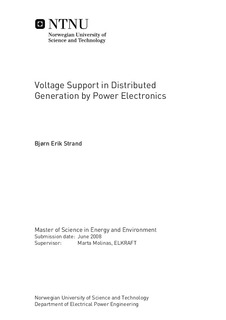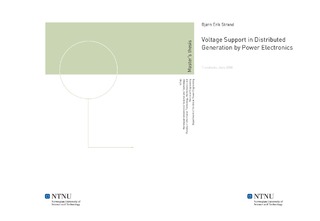| dc.contributor.advisor | Molinas, Marta | nb_NO |
| dc.contributor.author | Strand, Bjørn Erik | nb_NO |
| dc.date.accessioned | 2014-12-19T13:50:58Z | |
| dc.date.available | 2014-12-19T13:50:58Z | |
| dc.date.created | 2010-09-03 | nb_NO |
| dc.date.issued | 2008 | nb_NO |
| dc.identifier | 347708 | nb_NO |
| dc.identifier | ntnudaim:4312 | nb_NO |
| dc.identifier.uri | http://hdl.handle.net/11250/256507 | |
| dc.description.abstract | There is an increasing amount of power processed through power electronics in the areas of generation interface, energy storage and loads. This increment enables possibilities for improved solutions for efficient generation and use of electric power. Traditionally loads in AC distribution systems have been seen as passive and individual elements rather than active components of the system. An AC distribution system with high percentage of power electronic loads can be susceptible for instability under abnormal operation conditions if the converter controls are not designed for such conditions. This thesis introduces a solution of reactive current control for a constant power load (CPL) in an AC distribution system. A CPL is a load that draws a constant amount of active power without regard to any drops in system voltage. The resistance seen from the AC distribution system to the CPL is known as a negative input resistance which is characteristic for this kind of load. A drop in AC system voltage will result in increased current and vice versa. Hence the resulting resistance will be negative. Negative resistance behaviour is not favourable for system stability and the work has focused on a control of the converter that reduces the instability effect of the load. By controlling the reactive current component to inject current for support of the AC distribution system voltage during faults and other interferences, the load becomes an active participant in the AC distribution system. An AC distribution system has been built in PSCAD/EMTDC. An asynchronous generator and a fixed capacitor are used as distributed generation. The CPL consists of an AC/DC converter and a voltage dependent current source in order to keep constant DC power at the load. Focus has been on the converter control implementing a voltage oriented vector control based on a two phase rotational reference frame. Measurements of current and voltage with different voltage drop levels have been done for comparison of a CPL with and without reactive current control. The simulation example has verified the negative resistance phenomenon of the CPL. Results shows that the AC system voltage is less vulnerable in case of faults if the converter control is designed to inject reactive current into the AC distribution system. | nb_NO |
| dc.language | eng | nb_NO |
| dc.publisher | Institutt for elkraftteknikk | nb_NO |
| dc.subject | ntnudaim | no_NO |
| dc.subject | MSELPOWER Master of Science in Electric Power Engineering | no_NO |
| dc.subject | Elektrisk Energiteknikk | no_NO |
| dc.title | Voltage Support in Distributed Generation by Power Electronics | nb_NO |
| dc.type | Master thesis | nb_NO |
| dc.source.pagenumber | 83 | nb_NO |
| dc.contributor.department | Norges teknisk-naturvitenskapelige universitet, Fakultet for informasjonsteknologi, matematikk og elektroteknikk, Institutt for elkraftteknikk | nb_NO |

